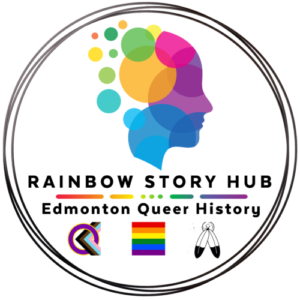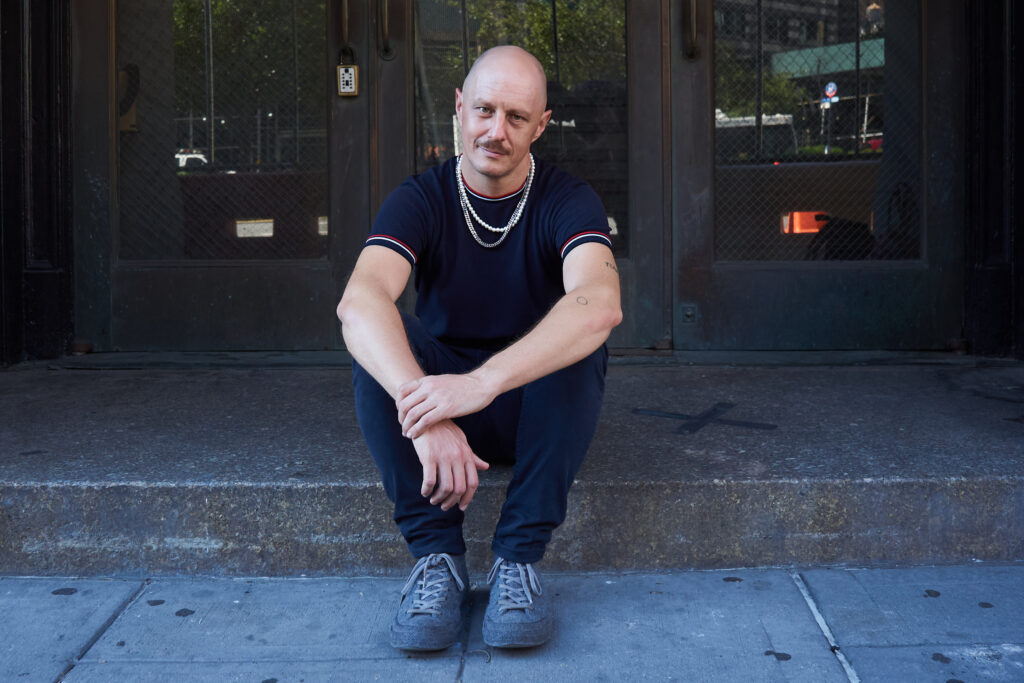
Theodore (ted) Kerr’s journey as a queer writer, artist, and community organizer is a story of movement—across cities, disciplines, and generations. Unsure of where he will next call home given the current upheavals in Canada and the U.S., Kerr’s work on HIV/AIDS cultural production and queer storytelling is internationally recognized. Yet his foundation was built in Edmonton, Alberta, where a blend of suburban upbringing, grassroots activism, and artistic experimentation first shaped his path.
Born in 1979, Kerr grew up in Edmonton’s West End, spending much of his youth at West Edmonton Mall and attending Jasper Place High School. He is the eldest of three siblings. His early understanding of queerness took shape through daytime talk shows, where drag queens, people living with HIV, and cultural outliers appeared regularly. These television moments, emblematic of the late twentieth century, provided glimpses of lives that defied heteronormative expectations and helped form a vocabulary of selfhood and solidarity.
Edmonton in the 1990s and early 2000s offered both barriers and bridges for queer youth. Kerr attended a high school where at least a handful of students could be visibly queer or gender-nonconforming and still find community. Alongside this, work and social spaces like the once-iconic Canadian clothing brand Le Château became informal cultural incubators where young people explored aesthetics, gender expression, and future possibilities. Though not overtly queer, these environments allowed for personal expression and shared imagination about adulthood and identity.
Kerr enrolled in courses at Grant MacEwan and the University of Alberta in the early 2000s, including a pivotal queer writing class with novelist and activist Ruth DyckFehderau. Those credits, combined with his growing portfolio as a writer and organizer, enabled him to apply as a mature student to The New School in New York City, where he completed his undergraduate degree. Before his move, Kerr had already been active in Edmonton’s cultural life: he wrote a biweekly column titled QUEERMONTON for VUE Weekly and contributed street fashion photography to SEE Magazine. These alternative publications were central to the city’s creative ecosystem and allowed Kerr to explore voice, critique, and representation.
One of the most significant early influences on Kerr’s development was his involvement with HIV Edmonton. By the time he joined as a volunteer and later as a staff member, the HIV/AIDS landscape had changed considerably—life-saving treatments had reduced mortality rates, but the cultural silence surrounding HIV remained. At the organization, Kerr was one of the few openly gay men, and he, along with Robert Smith, Dolan Badger, Lynn Sutankayo, and QC Gu, played an instrumental role in expanding the organization’s engagement with LGBTQ+ communities. His experiences there sharpened his awareness of the “Second Silence”—a generational gap in public discourse around HIV that Kerr would later write about extensively.
Alongside his work in health and advocacy, Kerr contributed to the founding of Exposure: Edmonton’s Queer Arts and Culture Festival. Exposure emerged in the mid-2000s as a multidisciplinary event intended to elevate queer artistic practices in a city still negotiating its relationship to LGBTQ+ visibility. The festival was a collaboration between artists, activists, and public figures—including Michael Phair, a former city councillor and longtime influence on Kerr’s political imagination. Exposure offered a space where queer meaning could be shaped collectively, informed by aesthetics and activism alike.
Kerr’s move to New York was catalyzed by a Canada Council grant intended for study with artist A.A. Bronson at The Banff Centre. When the program was cancelled, Bronson invited Kerr to participate in a residency at the Institute for Art, Religion and Social Justice at Union Theological Seminary in New York. That short-term residency evolved into a longer stay: Kerr began working with Bronson, enrolled at The New School, and eventually took a role at Visual AIDS, a New York-based arts organization committed to preserving and advancing the legacy of HIV/AIDS cultural work. Through these experiences, Kerr became a key figure in the ongoing conversation around HIV, art, and memory. He co-founded “What Would an HIV Doula Do?”—an international collective exploring the cultural and emotional labor of people living with and impacted by HIV. In 2022, he co-authored We Are Having This Conversation Now: The Times of AIDS Cultural Production with scholar and filmmaker Alexandra Juhasz—director of Video Remains(2005)and author of AIDS TV: Identity, Community, and Alternative Video(1995). Published with Duke University Press, their book maps the cultural work surrounding HIV/AIDS across multiple generations and argues for the continued urgency of this discourse, especially in a time when many assume the epidemic is behind us.
Over the years, Kerr has had the opportunity to bring together the skills he developed in Edmonton, along with the experiences he has accrued since he left. This includes performing oral histories for the Smithsonian, Archives for American Art, curating exhibitions for the U.S. National Library of Medicine; and working alongside other artists, writers and curators. In 2019, a public artwork he co-created with artist Carlos Motta and architect Koray Duman was longlisted for the High Line plinth commission in New York, and he was a principal artist in the award-winning exhibition Wish You Were Here/Wish Here Was Better at the Blackwood Gallery at the University of Toronto with activist Zoe Dodd and curator Ellyn Walker. Most recently, he contributed interviews to dancer Christopher House’s upcoming Dance Collection Danse exhibition, Stories of HIV/AIDS and Dance in Canada.
Kerr’s work is characterized by a deep commitment to intergenerational dialogue, community-based ethics, and the politics of storytelling. He often returns to questions of queer citizenship—not only as a legal or political status, but as a cultural practice shaped by pleasure, grief, friendship, and resistance. His writing, curatorial projects, and teaching foreground this ethic: that our stories, especially those rooted in marginalized identities and health crises, are crucial to how communities imagine justice and continuity.
Despite currently living in Brooklyn, Kerr maintains a meaningful connection to Edmonton. He owns an apartment in the city and continues to follow its cultural and political transformations closely. For a long time, as he has shared, he treated Edmonton as a time capsule—a place frozen in memory. But with time, that perception shifted. The city had grown, changed, and moved forward. Kerr had to reconcile with the fact that he could no longer return to a place that once was, instead, he had the opportunity to now visit and explore. This realization deepened his appreciation for the role of place in shaping identity, and the responsibilities that come with it.
Earlier this year, a portrait of Kerr by artist L.J. Roberts was acquired by the New York Historical Society, and he was named a 2025 awardee of the Monette-Horwitz Trust for his work sparking “critical conversations on public health and social equity, empowering marginalized communities and reshaping cultural narratives around HIV/AIDS and identity.” These honors came mere months after Kerr delivered a keynote in Vancouver at the Community-Based Research Centre national annual summit, where he spoke about the legacy of activism and art to connect the past, present and future of Canada’s HIV/AIDS response.
Kerr’s legacy in Edmonton is not only about what he accomplished during his years in the city, but also about the questions he continues to pose from afar: How can diverse communities hold space for queer lives? What role do cities play as personal and communal archives? What does it mean to respond to a health crisis through art? Who gets to tell these stories—and who listens? In a cultural moment marked by rapid shifts in public memory, Kerr’s work reminds us that the past is not static. It is something to be activated, interrogated, and shared. His story is not just about where he came from, or where he is now—but about what becomes possible when the stories we tell are as expansive as the lives we live.
Additional reading/viewing:
Theodore (ted) Kerr: Changing our understanding of HIV/AIDS culture
Consulate General of Canada New York
https://www.youtube.com/watch?v=6sws0mDxwaw
Top 40 Under 40 2010
Ted Kerr
Edify Magazine – November 1, 2010
https://edifyedmonton.com/people/top-40/2010/ted-kerr/
How did two HIV+ writers, decades apart, each end up writing stories called Hockey Night in Canada?
CBC Arts
https://www.cbc.ca/arts/how-did-two-hiv-writers-decades-apart-each-end-up-writing-stories-called-hockey-night-in-canada-1.6268078
![]()

Kyler Chittick
Kyler Chittick is a Ph.D. Candidate in the Department of Political Science at the University of Alberta, an instructor in the political science and women's studies programs at NorQuest College, as well as co-director of Rainbow Story Hub. From 2020 to 2022, he was part of the Edmonton Queer History Project (EQHP) at MacEwan University.
Kyler's research interests land at the intersections of queer theory and critical sexuality studies as they pertain to law, film, cultural studies, and contemporary political theory. His academic work appears in Alberta Law Review, Porn Studies, Senses of Cinema, and Synoptique. He has also contributed to Inside Higher Ed, Syndicate, and the Rainbow Story Hub website.






